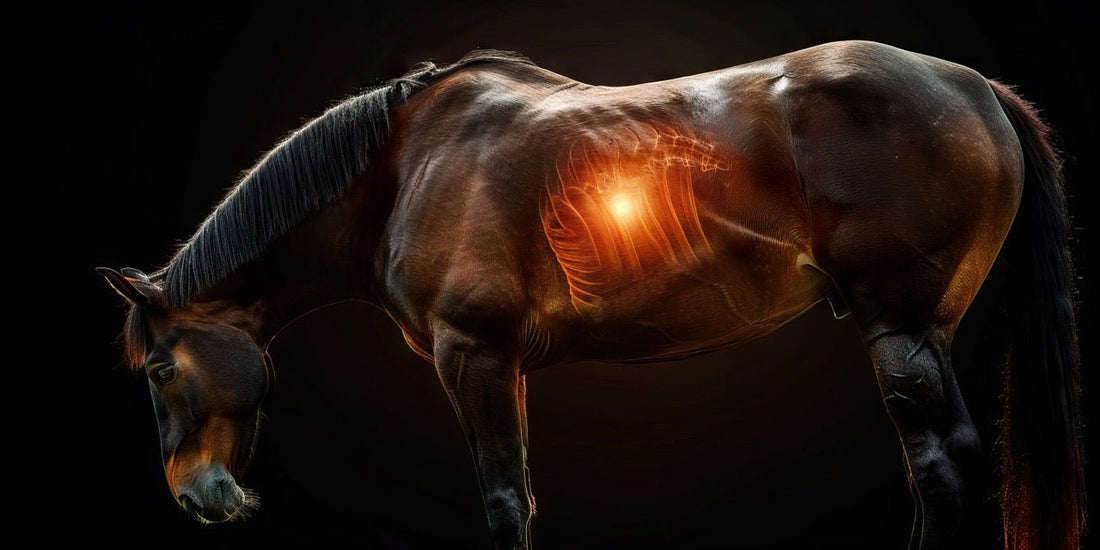
EGUS (Equine Gastric Ulcer Syndrome) – Gastric ulcer in horses
Guest article by the Esther Weber-Voigt Free Teaching Center ( EWV )
Gastric ulcer in horses - EGUS describes a serious symptom complex in horses characterized by lesions in the gastric mucosa. Gastric ulcer is one of the most common gastric diseases in horses.
There is a reported prevalence in (thoroughbred) racehorses (37%), especially in those actively involved in racing and competition. Here, the incidence is almost 100%. The lowest incidence rate occurs in non-competitive horses (approximately 11%).
However, other risk factors such as chronic stress due to training and transport or nutritional and social stressors such as incorrect or faulty feeding or changes in housing are also described in the literature and can affect horses of all breeds and ages.

Causes and origins
Gastric acid is continuously produced in the horse's stomach. However, the buffering saliva is primarily produced during chewing. If a horse is provided with insufficient roughage, this can lead to an imbalance between gastric acid and buffer, which in turn contributes to the development of lesions in the gastric mucosa.
Errors in feeding management, such as too long breaks between individual feedings or too high amounts of concentrate, can also lead to inconsistencies in the delicate balance between mucosal protective and mucosal damaging factors.
The mucus bicarbonate layer and prostaglandins (PGE) are considered protective substances. Hydrochloric acid, bile acids, pepsin, butyrate, propionate, and acetate are considered to be the most aggressive substances against the mucous membrane.
A serious general illness (infections, colic), orthopedic problems or another underlying chronic disease, as well as medications (long-term treatment with non-steroidal anti-inflammatory drugs (painkillers) and corticosteroids) can also be responsible for the development of an ulcer.
Equine gastric ulcer syndrome is a multifactorial condition. Several causes must coincide to trigger a clinically manifest disease.
Symptoms and diagnostics
The symptoms of erosive and ulcerative gastroduodenopathies depend on the severity and duration of the disease and are generally nonspecific. Affected horses often experience reduced or selective appetite, or even loss of appetite. This results in poor general well-being and weight loss. The horse's appearance and behavior also change significantly. The coat becomes dull, and there is often a significant loss of performance, bruxism (teeth grinding), and ptyalism (excessive salivation). Increased yawning or flehmen may also be observed. The horse becomes sensitive in the stomach area and may no longer respond well to grooming. Recurrent colic can also occur in conjunction with gastric ulcers.
In suckling foals, the symptoms are often more pronounced and pathognomic for EGUS. Teeth grinding, foetor ex ore (bad breath), hypersalivation, and abrupt cessation of suckling with colic-like symptoms are typical.
Gastroscopy is considered the gold standard in diagnosis. Under light sedation, a video endoscope is inserted through the nose, first into the esophagus and then further into the stomach (and the beginning of the duodenum), and the mucosa is examined.
Equine Gastric Ulcer Syndrome is further divided into two subtypes, depending on the anatomical occurrence of the lesions.
If the lesions are mainly located in the non-glandular part of the stomach (pars non-glandularis), it is called ESGD (equine squamous gastric disease) .
The following degrees of severity are distinguished based on the pathological changes in the mucous membrane:
Grade 0 – No visible changes
Grade 1 – Intact mucosa, but hyperkeratotic areas
Grade 2 – Small, single or multifactorial lesions
Grade 3 – Large, single or multifactorial lesions
Grade 4 – Deep lesions with ulcerations
If the lesions are located in the glandular part of the stomach (pars glandularis), it is called EGGD (equine glandular gastric disease) .
Unlike ESGD, EGGD findings are not classified by severity. Only the location and type of changes are described.

Gastric ulcer in horses - the therapy
The type and duration of treatment, as well as the etiology, are multifactorial and depend on the severity of the findings. Fundamentally, all predisposing factors must be eliminated. In particular, the feeding of affected horses should be professionally reviewed and optimized if necessary.
Drug therapy by the treating veterinarian is essential in most cases. The most commonly used medications are proton pump inhibitors (omeprazole / GastroGard® 370 mg) and sucralfate (Sucrabest® 1 g granules). Prokinetic medications such as metoclopramide can also be administered. These improve the delayed gastric emptying often seen in EGUS and help maintain normal digestion.
The success of the therapy is checked a few weeks after the start (four to eight weeks) by a repeat gastroscopy.
Discontinuation of medication too early or irregular administration can lead to a recurrence. If a gastric ulcer perforates, it can result in peritonitis (inflammation of the peritoneum), which can quickly kill the horse.
Conclusion
Gastric ulcers in horses are a common gastric disease with many possible causes and serious consequences for the animal. Early detection of symptoms and appropriate treatment are essential for a favorable prognosis.
Sources
- DocCheck Flexikon: Equine Glandular Gastric Disease (Horse)
- Thieme VetCenter – horse mirror 2015; 18(1): 22–31
- Thieme VetCenter – Handbook of Equine Practice. Brehm W, Gehlen H, Ohnesorge B, Wehrend A, eds. 4th edition. Enke Verlag, Stuttgart 2016
- PubMed: Equine Gastric Ulcer Syndrome: An Update on Current Knowledge – Jessica Vokes et al. (PMID: 37048517, DOI )
